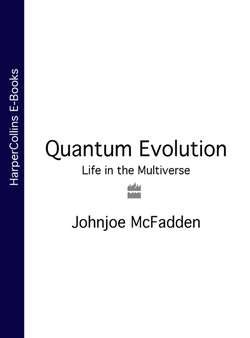Читать книгу Quantum Evolution: Life in the Multiverse - Johnjoe McFadden - Страница 23
THE DOUBLE HELIX
ОглавлениеThe intertwined DNA molecule has become such a strong cultural icon today that it is hard to realise just how unobvious its structure was in the 1950s. Both laboratories racing for a solution initially got it wrong. Linus Pauling of the California Institute of Technology (CalTech) was perhaps the greatest chemist of the twentieth century. He had already discovered proteins contained helical regions so it was hardly surprising that he proposed a helical structure for DNA. However, he wrongly proposed a triple helical structure.
James Watson was an American scientist who came to Cambridge’s Cavendish Laboratory to learn protein biochemistry. However, his real interest was DNA and at Cambridge he teamed up with the Englishman Francis Crick to solve the structure of that ‘most golden of all molecules’.2 Watson and Crick’s first stab at a structure for DNA was (like Pauling’s) also a triple-stranded helix. The pair rashly invited the UK experts on DNA, Maurice Wilkins and Rosalind Franklin, to the unveiling of their putative structure. Wilkins and Franklin had travelled from King’s College, London to view the new model but felt their trip had been wasted when it took just a few minutes for Franklin to spot crucial flaws in the triple helix. After a hasty, tense lunch, the King’s Group rushed off to catch their train home.
News of this débâcle soon reached Sir Lawrence Bragg, chief of the Cavendish laboratory and Watson and Crick were instructed to turn their attentions to less challenging molecules. The pair decided to continue surreptitiously with their model-building. Their approach used wire models representing the chemical groups to build (quite literally) a structure in three-dimensional space that, they hoped, would represent DNA’s actual structure. But how could they know whether their structure was correct? The key was Rosalind Franklin’s X-ray crystallography data – which was essentially an X-ray of the DNA molecule. The problem, according to Watson, was the difficulty they experienced getting a look at the data over the shoulder of the allegedly overly secretive Franklin. Yet between the lines of Watson’s very readable account, The Double Helix, you can read something of the cultural landscape that forged Franklin’s diffidence. Watson’s describes his female colleague:
‘Though her features were strong, she was not unattractive and might have been quite stunning had she taken even a mild interest in her clothes. This she did not. There was never lipstick to contrast with her straight black hair, while at the age of thirty-one her dresses showed all the imagination of the English blue-stocking adolescents.’
There is unfortunately no record of Franklin’s opinion of the good looks and dress sense of her male colleagues. Some inkling of her likely feelings may be garnered from Watson’s account of a particularly frank exchange of views between himself and ‘Rosy’ which ended with her bearing down upon him with a glint of violent retribution in her eyes. Watson was saved from a justly deserved slap by the entry of Franklin’s colleague, Maurice Wilkins.
With the help of Wilkins (though behind Franklin’s back) Watson and Crick finally managed to get a good look at her latest X-ray pictures of DNA and were quick to recognize the telltale image of a helix. Several days of frantic model-building resulted in their triumphant unveiling of the double helical form of DNA. The first to share in the newly discovered ‘secret of life’ were the regulars of the Eagle, the pub just outside the Cavendish laboratories. But a paper was soon drafted to Nature which ended with the classic understatement: ‘It has not escaped our notice that the specific pairing we have postulated immediately suggests a possible copying mechanism for the genetic material.’ According to Crick, their intention was not to be coy but was born of Watson’s fear that he might ‘make an ass of himself by saying too much too soon.
